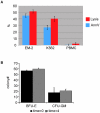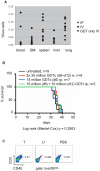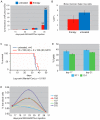Anti-leukemia activity of in vitro-expanded human gamma delta T cells in a xenogeneic Ph+ leukemia model
- PMID: 21304898
- PMCID: PMC3033392
- DOI: 10.1371/journal.pone.0016700
Anti-leukemia activity of in vitro-expanded human gamma delta T cells in a xenogeneic Ph+ leukemia model
Abstract
Gamma delta T cells (GDTc) lyse a variety of hematological and solid tumour cells in vitro and in vivo, and are thus promising candidates for cellular immunotherapy. We have developed a protocol to expand human GDTc in vitro, yielding highly cytotoxic Vgamma9/Vdelta2 CD27/CD45RA double negative effector memory cells. These cells express CD16, CD45RO, CD56, CD95 and NKG2D. Flow cytometric, clonogenic, and chromium release assays confirmed their specific cytotoxicity against Ph(+) cell lines in vitro. We have generated a fluorescent and bioluminescent Ph(+) cell line, EM-2eGFPluc, and established a novel xenogeneic leukemia model. Intravenous injection of EM-2eGFPluc into NOD.Cg-Prkdcscid Il2rgtm1Wjl/SzJ (NSG) mice resulted in significant dose-dependent bone marrow engraftment; lower levels engrafted in blood, lung, liver and spleen. In vitro-expanded human GDTc injected intraperitoneally were found at higher levels in blood and organs compared to those injected intravenously; GDTc survived at least 33 days post-injection. In therapy experiments, we documented decreased bone marrow leukemia burden in mice treated with GDTc. Live GDTc were found in spleen and bone marrow at endpoint, suggesting the potential usefulness of this therapy.
Conflict of interest statement
Figures






Similar articles
-
Human Vδ1 γδ T cells expanded from peripheral blood exhibit specific cytotoxicity against B-cell chronic lymphocytic leukemia-derived cells.Cytotherapy. 2011 Jul;13(6):753-64. doi: 10.3109/14653249.2011.553595. Epub 2011 Feb 11. Cytotherapy. 2011. PMID: 21314241
-
Extensive expansion of primary human gamma delta T cells generates cytotoxic effector memory cells that can be labeled with Feraheme for cellular MRI.Cancer Immunol Immunother. 2013 Mar;62(3):571-83. doi: 10.1007/s00262-012-1353-y. Epub 2012 Oct 26. Cancer Immunol Immunother. 2013. PMID: 23100099 Free PMC article.
-
Expansion of Philadelphia chromosome-negative CD3(+)CD56(+) cytotoxic cells from chronic myeloid leukemia patients: in vitro and in vivo efficacy in severe combined immunodeficiency disease mice.Blood. 1998 Nov 1;92(9):3318-27. Blood. 1998. PMID: 9787169
-
An animal model for human cellular immunotherapy: specific eradication of human acute lymphoblastic leukemia by cytotoxic T lymphocytes in NOD/scid mice.Blood. 2002 Jul 15;100(2):654-60. doi: 10.1182/blood.v100.2.654. Blood. 2002. PMID: 12091361
-
Novel adoptive T-cell immunotherapy using a WT1-specific TCR vector encoding silencers for endogenous TCRs shows marked antileukemia reactivity and safety.Blood. 2011 Aug 11;118(6):1495-503. doi: 10.1182/blood-2011-02-337089. Epub 2011 Jun 14. Blood. 2011. PMID: 21673345
Cited by
-
Anti-leukemia activity of human gamma delta T cells.Oncoimmunology. 2012 Mar 1;1(2):237-239. doi: 10.4161/onci.1.2.18231. Oncoimmunology. 2012. PMID: 22720255 Free PMC article.
-
Chronic myeloid leukemia patients in prolonged remission following interferon-α monotherapy have distinct cytokine and oligoclonal lymphocyte profile.PLoS One. 2011;6(8):e23022. doi: 10.1371/journal.pone.0023022. Epub 2011 Aug 9. PLoS One. 2011. PMID: 21857985 Free PMC article.
-
Cytotoxic and regulatory properties of circulating Vδ1+ γδ T cells: a new player on the cell therapy field?Mol Ther. 2014 Aug;22(8):1416-1422. doi: 10.1038/mt.2014.104. Epub 2014 Jun 4. Mol Ther. 2014. PMID: 24895997 Free PMC article. Review.
-
Azathioprine therapy selectively ablates human Vδ2⁺ T cells in Crohn's disease.J Clin Invest. 2015 Aug 3;125(8):3215-25. doi: 10.1172/JCI80840. Epub 2015 Jul 13. J Clin Invest. 2015. PMID: 26168223 Free PMC article. Clinical Trial.
-
Aberrantly Expressed Embryonic Protein NODAL Alters Breast Cancer Cell Susceptibility to γδ T Cell Cytotoxicity.Front Immunol. 2020 Jun 19;11:1287. doi: 10.3389/fimmu.2020.01287. eCollection 2020. Front Immunol. 2020. PMID: 32636849 Free PMC article.
References
-
- Lamb LS, Jr, Lopez RD. gammadelta T cells: a new frontier for immunotherapy? Biol Blood Marrow Transplant. 2005;11:161–168. - PubMed
-
- Ensslin AS, Formby B. Comparison of cytolytic and proliferative activities of human gamma delta and alpha beta T cells from peripheral blood against various human tumor cell lines. J Natl Cancer Inst. 1991;83:1564–1569. - PubMed
-
- Zheng BJ, Chan KW, Im S, Chua D, Sham JS, et al. Anti-tumor effects of human peripheral gammadelta T cells in a mouse tumor model. Int J Cancer. 2001;92:421–425. - PubMed
-
- Kabelitz D, Wesch D, He W. Perspectives of gammadelta T cells in tumor immunology. Cancer Res. 2007;67:5–8. - PubMed
-
- Viey E, Lucas C, Romagne F, Escudier B, Chouaib S, et al. Chemokine receptors expression and migration potential of tumor-infiltrating and peripheral-expanded Vgamma9Vdelta2 T cells from renal cell carcinoma patients. J Immunother. 2008;31:313–323. - PubMed
Publication types
MeSH terms
Substances
LinkOut - more resources
Full Text Sources
Other Literature Sources
Medical
Research Materials

